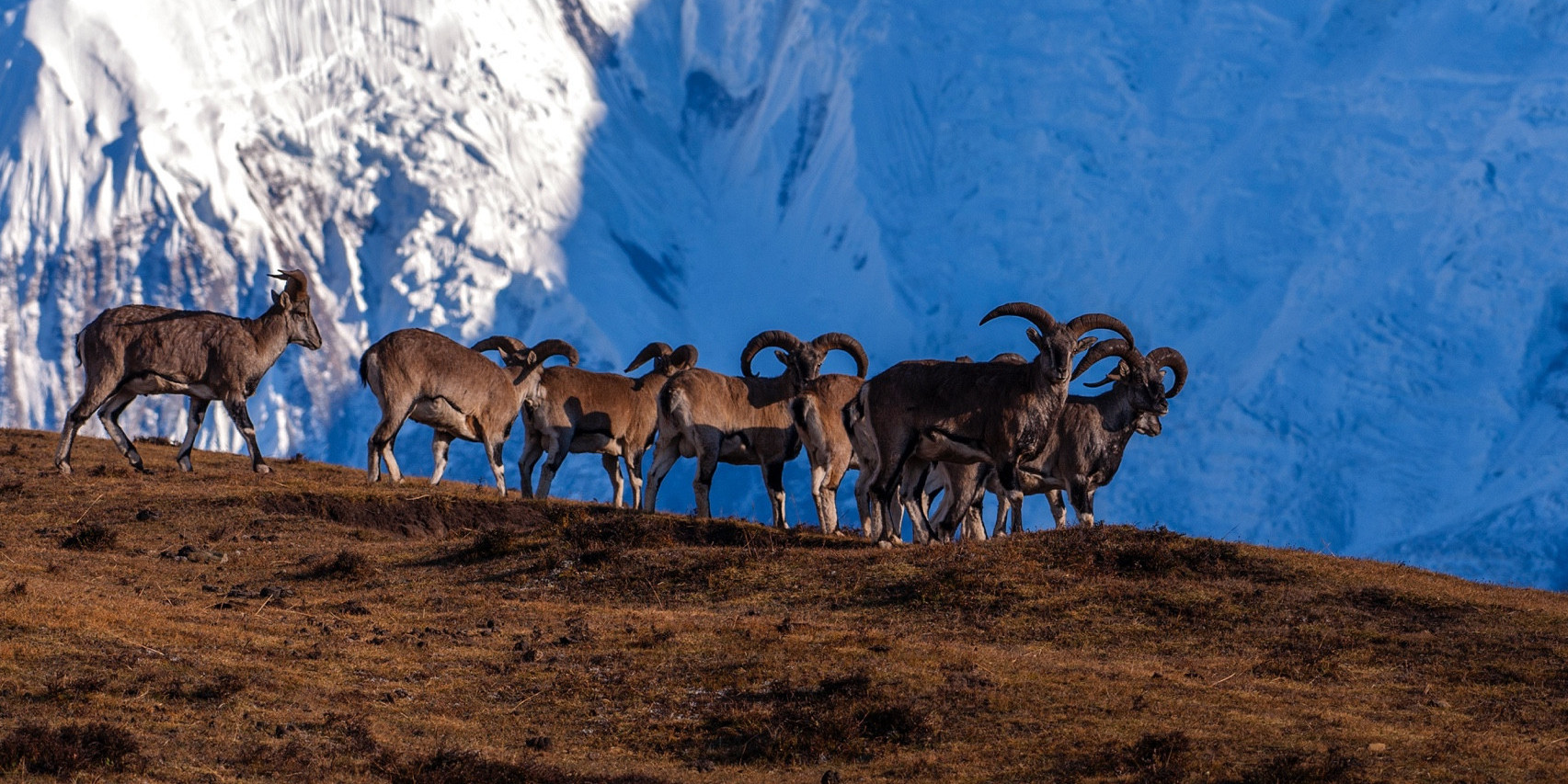Conservation Areas
Conservation areas in Nepal are managed with a unique approach that combines environmental protection with sustainable community development. These areas are specifically designed to preserve the country's rich biodiversity while promoting the well-being of the local populations who are integral to the conservation efforts. Here’s an overview of the main conservation areas in Nepal:
Annapurna Conservation Area
The Annapurna Conservation Area (ACA) stands as Nepal's largest and most diverse protected area, spanning over 7,629 square kilometers across five districts: Manang, Mustang, Kaski, Myagdi, and Lamjung. Established in 1986, it was the first conservation area in Nepal and remains a pioneering project in the field of sustainable community-based conservation practices.
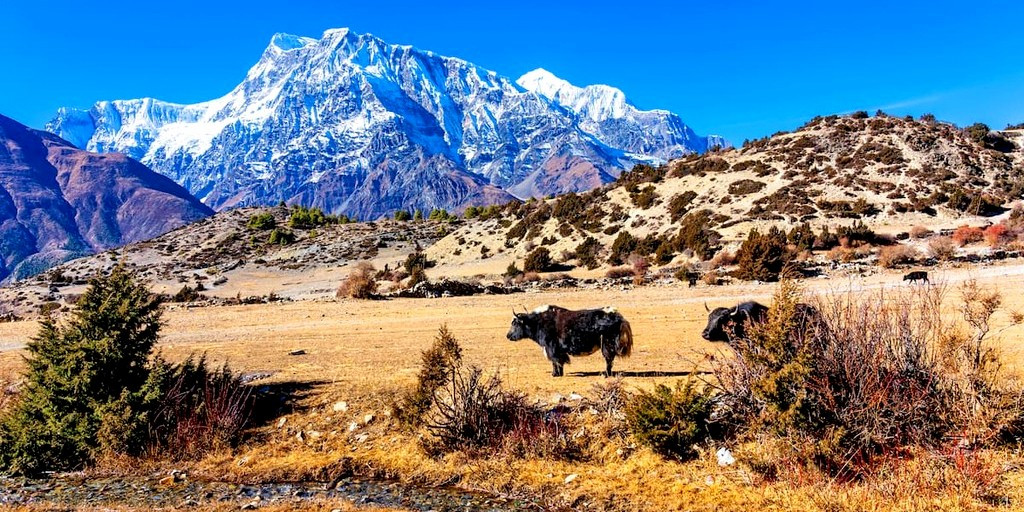
-
Ecological and Cultural Diversity: The ACA is renowned for its incredible ecological diversity, encompassing subtropical rainforests in the low-lying areas to arctic conditions in the high-altitude zones. The region is home to Annapurna I, which at 8,091 meters, is the 10th highest peak in the world, as well as thirteen additional peaks over 7,000 meters and 16 more over 6,000 meters. This vast range of altitudes and climates supports an impressive array of flora and fauna. Over 1,226 species of flowering plants, 105 mammals, 518 birds, and 40 reptiles have been recorded. Notable wildlife includes the snow leopard, Himalayan tahr, and the blue sheep.
-
Trekking and Tourism: The Annapurna Conservation Area is a magnet for trekkers and offers a variety of trekking routes including the world-famous Annapurna Circuit, the Annapurna Base Camp trek, and more secluded paths like the Nar-Phu Valley trek. These routes provide breathtaking views of the Himalayan landscape and offer an opportunity to experience the rich cultural heritage of the ethnic communities such as the Gurungs, Manangis, and Thakalis. The area's unique approach to conservation integrates tourism and community development, with local residents managing natural resources and sharing the benefits of tourism.
-
Conservation and Community Efforts: ACA's management strategy is distinctive because it focuses on generating economic benefits for the local communities to enhance their livelihood while ensuring environmental conservation. The Annapurna Conservation Area Project (ACAP), initiated by the National Trust for Nature Conservation (NTNC), has been instrumental in this. ACAP has set up various eco-museums, visitor centers, and implemented numerous sustainable development programs such as micro-hydro projects, sustainable agriculture practices, and waste management systems.
-
Environmental Impact and Sustainability: Tourism in the Annapurna area, while beneficial economically, also poses challenges such as waste management, trail erosion, and wood consumption for fuel. ACAP continuously works to mitigate these impacts through various conservation and sustainability initiatives. This includes promoting alternative energy sources, enforcing conservation laws, and educating both locals and tourists about environmental stewardship.
The Annapurna Conservation Area not only offers an exemplary model of how conservation efforts can be aligned with community benefits but also provides a spectacular setting for experiencing Nepal's natural beauty and cultural richness. Its success is a testament to the potential of community-based conservation in protecting natural environments while improving the lives of local inhabitants.
Manaslu Conservation Area
The Manaslu Conservation Area (MCA) is a protected area in Nepal established in 1998 to conserve the natural resources and cultural heritage of the Manaslu region. Spanning an area of approximately 1,663 square kilometers, it encompasses parts of the Gorkha district and is centered around Mount Manaslu, the world's eighth highest peak, standing at 8,163 meters.
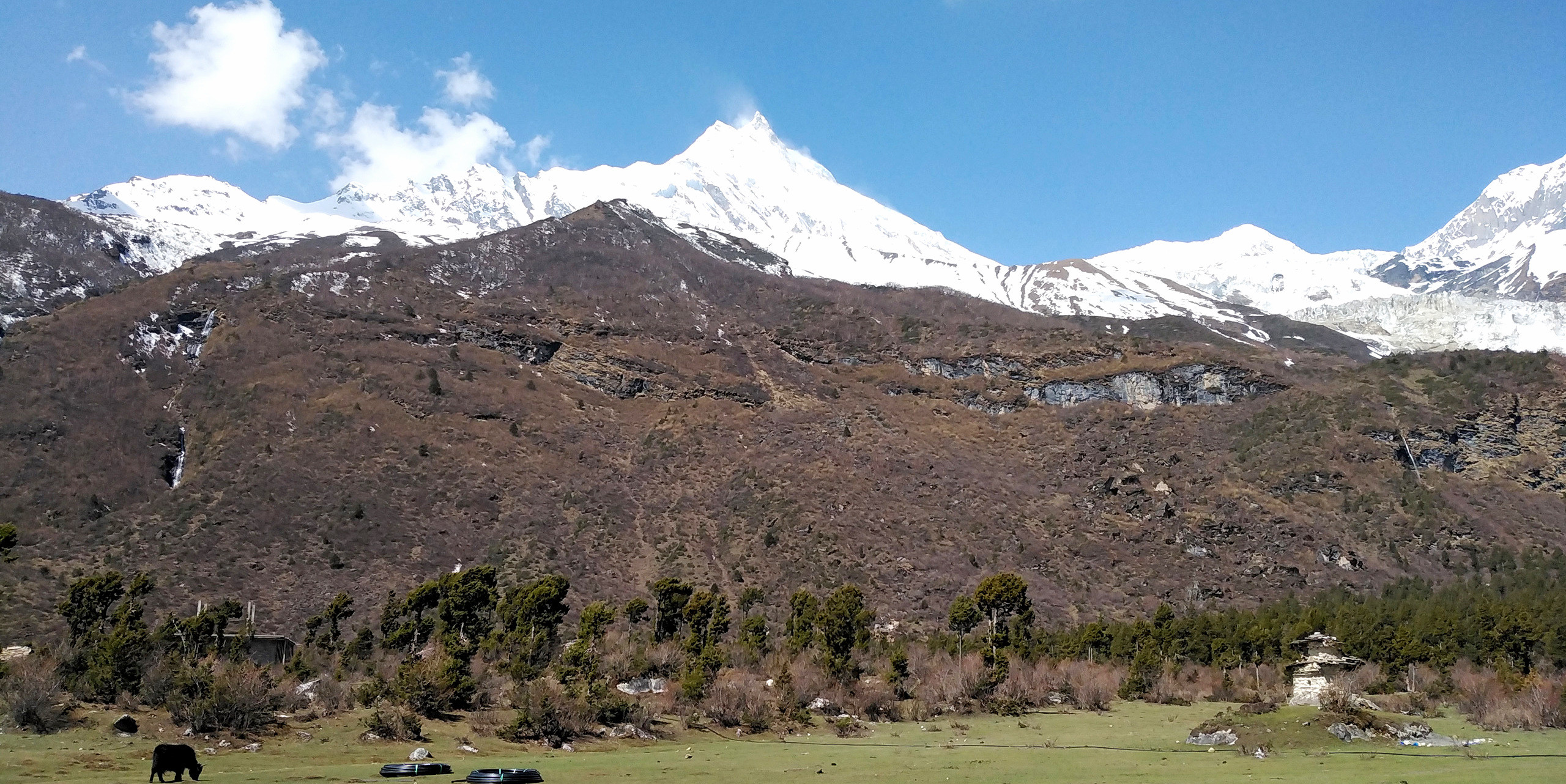
-
Biodiversity and Ecosystems: The Manaslu Conservation Area is characterized by a rich biodiversity that thrives across a range of altitudes from around 600 meters to the peak of Manaslu. This variation in altitude has resulted in diverse ecological zones, from lush sub-tropical forests at lower altitudes to the alpine and arctic zones at higher elevations. The area is home to a plethora of wildlife including endangered species such as the snow leopard, Himalayan tahr, and red panda. Over 110 species of birds, 33 mammals, 11 butterflies, and 3 reptiles have been documented in the region.
-
Cultural Significance: The MCA is also a region of great cultural importance, predominantly inhabited by the Nubri and Tsum ethnic groups, who have their own unique languages, customs, and practices. These communities live in close harmony with nature, which is reflected in their lifestyle and traditional practices. The region is dotted with ancient monasteries, chortens, mani walls, and other Buddhist religious symbols that add to the spiritual significance of the trek through this area.
-
Trekking and Exploration: Manaslu Conservation Area is renowned for the Manaslu Circuit Trek, which is becoming increasingly popular as a quieter alternative to the more crowded treks in Nepal, such as the Annapurna Circuit. The trek offers stunning views of Manaslu and the surrounding peaks, and passes through many villages that offer a glimpse into rural Nepalese life. This trek is known for its remote and rugged beauty, providing an adventure for trekkers who wish to experience both the natural and cultural wealth of Nepal.
-
Conservation Efforts: The conservation efforts in the Manaslu Conservation Area are managed by the National Trust for Nature Conservation (NTNC) with the primary aim of preserving the biodiversity and cultural heritage while promoting sustainable development practices. Initiatives include promoting alternative energy, managing waste, protecting wildlife habitats, and supporting local communities through eco-tourism. These efforts help ensure that both the natural environment and the local cultures are preserved for future generations.
-
Sustainable Tourism: The approach to tourism in Manaslu is focused on sustainability. Visitors are encouraged to follow eco-friendly practices and respect the delicate balance of nature and culture in the region. The revenue from trekking permits contributes directly to conservation projects and community welfare, enhancing the infrastructure and lives of the local people.
The Manaslu Conservation Area stands as a beacon of successful conservation where the preservation of nature goes hand in hand with cultural respect and sustainable development. It offers a less trodden, yet profoundly enriching, experience for those eager to explore the diversity and beauty of Nepal's highlands.
Gaurishankar Conservation Area
The Gaurishankar Conservation Area, established in 2010, is one of Nepal's newer protected regions, created to safeguard the biodiversity and enhance the livelihood of the local communities around the Gaurishankar mountain range. Covering approximately 2,179 square kilometers across the districts of Dolakha, Ramechhap, and Sindhupalchowk, this area is named after Mount Gaurishankar, a prominent peak that is revered as sacred by both Hindus and Buddhists.
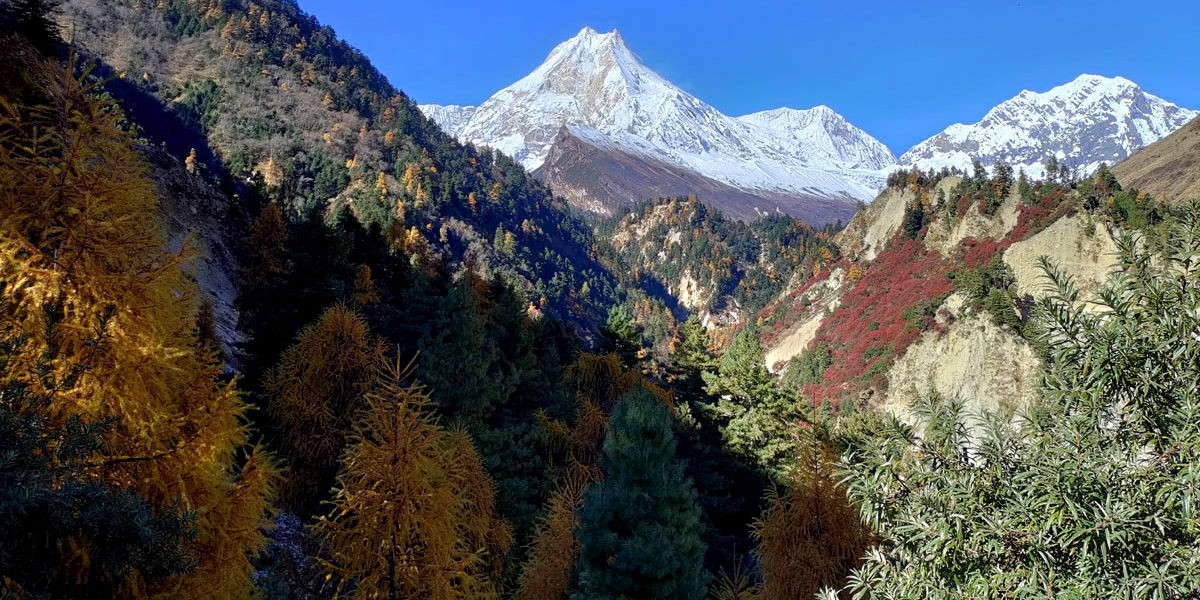
-
Biodiversity and Natural Features: The Gaurishankar Conservation Area boasts a varied landscape that ranges from lush, lowland forests to rugged, high-altitude terrain reaching elevations of over 7,000 meters. This diversity of ecosystems supports a wide array of flora and fauna. The area is a habitat for several threatened species including the red panda, snow leopard, and Himalayan tahr. It is also rich in bird species, making it a vital bird area for conservation.
-
Cultural Significance: The region holds immense cultural and spiritual significance, with Mount Gaurishankar considered the abode of Lord Shiva by Hindus and a sacred site by local Buddhist communities. This sanctity has led to a harmonious relationship between the region’s biodiversity and its inhabitants, who have a deep respect for the natural world. Numerous ancient monasteries, chortens, and shrines are scattered throughout the conservation area, adding to its cultural richness.
-
Trekking and Tourism: Although less frequented by tourists compared to the Annapurna and Everest regions, Gaurishankar offers a more secluded and authentic trekking experience. The conservation area features several trekking routes that provide stunning vistas of the Himalayan landscape, including views of Gaurishankar itself. Treks in this region are known for their scenic beauty, remote trails, and the opportunity to witness traditional Sherpa and Tamang life.
-
Conservation and Community Initiatives: Management of the Gaurishankar Conservation Area is overseen by the Department of National Parks and Wildlife Conservation with a strong emphasis on community involvement. Local conservation committees are active in managing natural resources and implementing sustainable practices. These efforts are crucial in promoting eco-tourism and providing economic benefits to the local populations.
-
Sustainable Development: Initiatives within the conservation area also focus on sustainable development, including promoting alternative energy sources, improving waste management, and enhancing agricultural practices. These measures help reduce environmental impacts while boosting local agriculture and energy independence.
The Gaurishankar Conservation Area exemplifies the balance between ecological protection and community development. Its establishment not only helps preserve critical ecosystems and endangered species but also supports the socio-economic growth of the local communities, making it a model for conservation efforts in Nepal. For those seeking an immersive experience in both natural beauty and cultural heritage, Gaurishankar provides an exceptional destination.
Kanchenjunga Conservation Area
The Kanchenjunga Conservation Area, located in the northeastern part of Nepal, is named after Mount Kanchenjunga, the third highest peak in the world. Established in 1997, this conservation area spans approximately 2,035 square kilometers and is a part of the larger Eastern Himalayan eco-region. Its diverse landscapes range from lush rhododendron forests to the towering, icy peaks of Kanchenjunga.
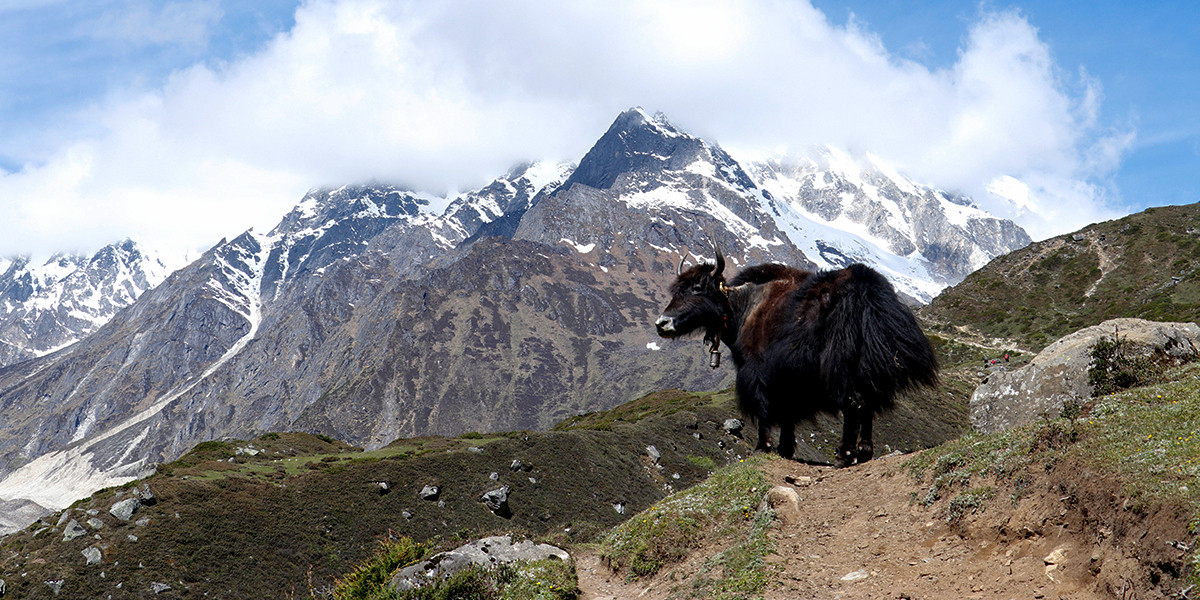
-
Biodiversity and Ecosystems: Kanchenjunga Conservation Area is home to a rich array of biodiversity. Its varied ecosystems, which range from subtropical rainforests at lower altitudes to alpine grasslands at higher elevations, host over 250 species of birds and numerous wildlife species, including the snow leopard, red panda, Himalayan black bear, and musk deer. The area's diverse flora and fauna make it a significant site for both ecological and scientific research.
-
Cultural Significance: The region is predominantly inhabited by ethnic groups such as the Limbu, Sherpa, and Rai, each with their own unique cultural identities and traditions. These communities have a profound respect for the natural environment, often reflected in their religious practices and folklore. The local culture is deeply intertwined with the conservation efforts, as many natural sites are considered sacred and are protected through community-led initiatives.
-
Trekking and Adventure: Trekking in the Kanchenjunga Conservation Area offers a unique opportunity for adventurers and nature lovers to explore one of the less frequented regions of the Himalayas. The area provides several trekking routes, including the challenging Kanchenjunga Base Camp trek, which is known for its remote beauty and dramatic mountain views. The treks not only offer a chance to witness the stunning landscapes and diverse wildlife but also to experience the rich cultural heritage of the local communities.
-
Conservation Efforts: The management of the Kanchenjunga Conservation Area is overseen by the Department of National Parks and Wildlife Conservation in partnership with local communities and non-governmental organizations. These collaborative efforts focus on preserving the natural environment while promoting sustainable livelihoods through eco-tour on ism and other conservation-linked enterprises. Programs aimed at habitat restoration, anti-poaching operations, and community awareness play a crucial role in the conservation of biodiversity within the area.
-
Sustainable Tourism: Tourism in the Kanchenjunga Conservation Area is carefully managed to ensure minimal environmental impact. The promotion of eco-friendly tourism practices helps maintain the area's ecological balance and supports the conservation of its vast natural resources. Tourists are encouraged to adhere to strict guidelines to minimize their footprint, contributing to the conservation goals while enhancing their travel experience.
The Kanchenjunga Conservation Area is a testament to the balance that can be achieved between natural preservation and cultural respect. It stands as a beacon of successful community-based conservation, offering visitors a profound connection with nature and an insightful glimpse into the lives of its indigenous peoples. For those seeking solitude, adventure, and a deeper understanding of Himalayan ecology and culture, the Kanchenjunga Conservation Area is an unparalleled destination.
Api Nampa Conservation Area
The Api Nampa Conservation Area, established in 2010, is situated in the far western region of Nepal, primarily in the Darchula District. This conservation area covers approximately 1,903 square kilometers, centering around two of the region’s most prominent peaks: Mount Api and Mount Nampa. It is one of the newest and most remote conservation efforts in Nepal, designed to preserve the unique biodiversity and cultural heritage of the area.
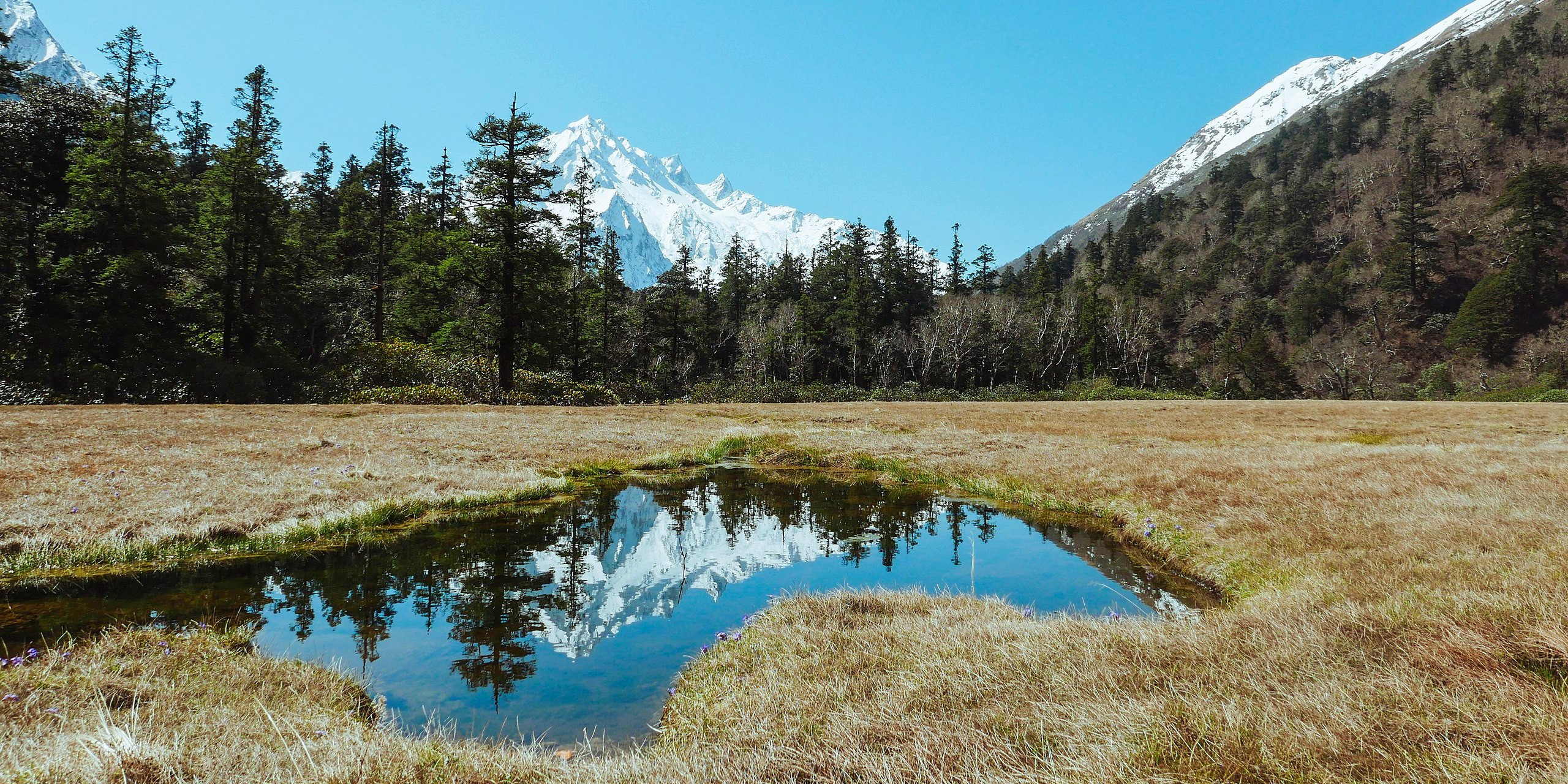
-
Biodiversity and Ecosystems: Api Nampa Conservation Area is characterized by its rugged terrain, which ranges from lush green valleys to stark, high-altitude landscapes. The area is particularly known for its rich biodiversity, including several endangered species such as the snow leopard, Himalayan musk deer, and the red panda. The conservation area's diverse ecosystems support a wide variety of flora, including medicinal herbs and high-altitude plants that are rare and endemic to the region.
-
Cultural Significance: The conservation area is also culturally significant, with a predominant population of the Rung and Byansi communities, who have their own distinct languages, customs, and religious beliefs. Many of the sites within the Api Nampa Conservation Area are considered sacred by the local communities, including the holy lake of Kali Dhunga. These cultural aspects are integrated into the conservation efforts, promoting a holistic approach that respects and preserves both natural and cultural heritage.
-
Trekking and Exploration: Api Nampa Conservation Area offers a pristine and less-traveled route for trekkers seeking solitude and adventure. The landscape provides breathtaking views of the Himalayas, untouched by mass tourism. Trekking routes in this area are challenging due to their remoteness and the ruggedness of the terrain, offering an authentic experience for those looking to explore off-the-beaten-path destinations.
-
Conservation Efforts: Conservation initiatives in Api Nampa focus on protecting the area's ecological integrity while fostering sustainable livelihoods for the local populations. Efforts include habitat preservation, anti-poaching measures, and the promotion of sustainable use of natural resources. The conservation area is managed by a collaboration between the government, local communities, and various environmental organizations, ensuring that both conservation goals and community needs are met.
-
Sustainable Development: Sustainable development projects within the conservation area are geared towards improving the quality of life for local residents while maintaining environmental sustainability. These projects often involve eco-tourism, the sustainable harvest of medicinal plants, and community-led tourism, which provide economic benefits to the locals and encourage conservation-friendly practices.
The Api Nampa Conservation Area is a shining example of how remote and natural landscapes can be effectively conserved through community involvement and sustainable practices. It offers a unique opportunity for visitors to experience the breathtaking beauty of the Himalayas while contributing to the preservation of this fragile ecosystem and the well-being of its indigenous communities.
Wildlife Reserves
Wildlife reserves in Nepal are key components of the country's efforts to preserve its diverse and unique natural heritage. These reserves are specifically established to protect wildlife and their habitats, while also allowing for the sustainable use of resources. Each reserve in Nepal offers a distinct experience and plays a crucial role in conservation, research, and education. Here's an overview of some of the prominent wildlife reserves in Nepal:
Koshi Tappu Wildlife Reserve
Koshi Tappu Wildlife Reserve is a gem within Nepal's network of protected areas, recognized primarily for its significance as a birdwatcher's paradise. Established in 1976 and spanning an area of approximately 175 square kilometers, this reserve lies in the floodplain of the Sapta-Koshi River in eastern Nepal. It was designated to protect the fragile ecosystem of the Koshi River, and it has gained an international reputation as a Ramsar site since 1987 due to its importance as a wetland habitat.
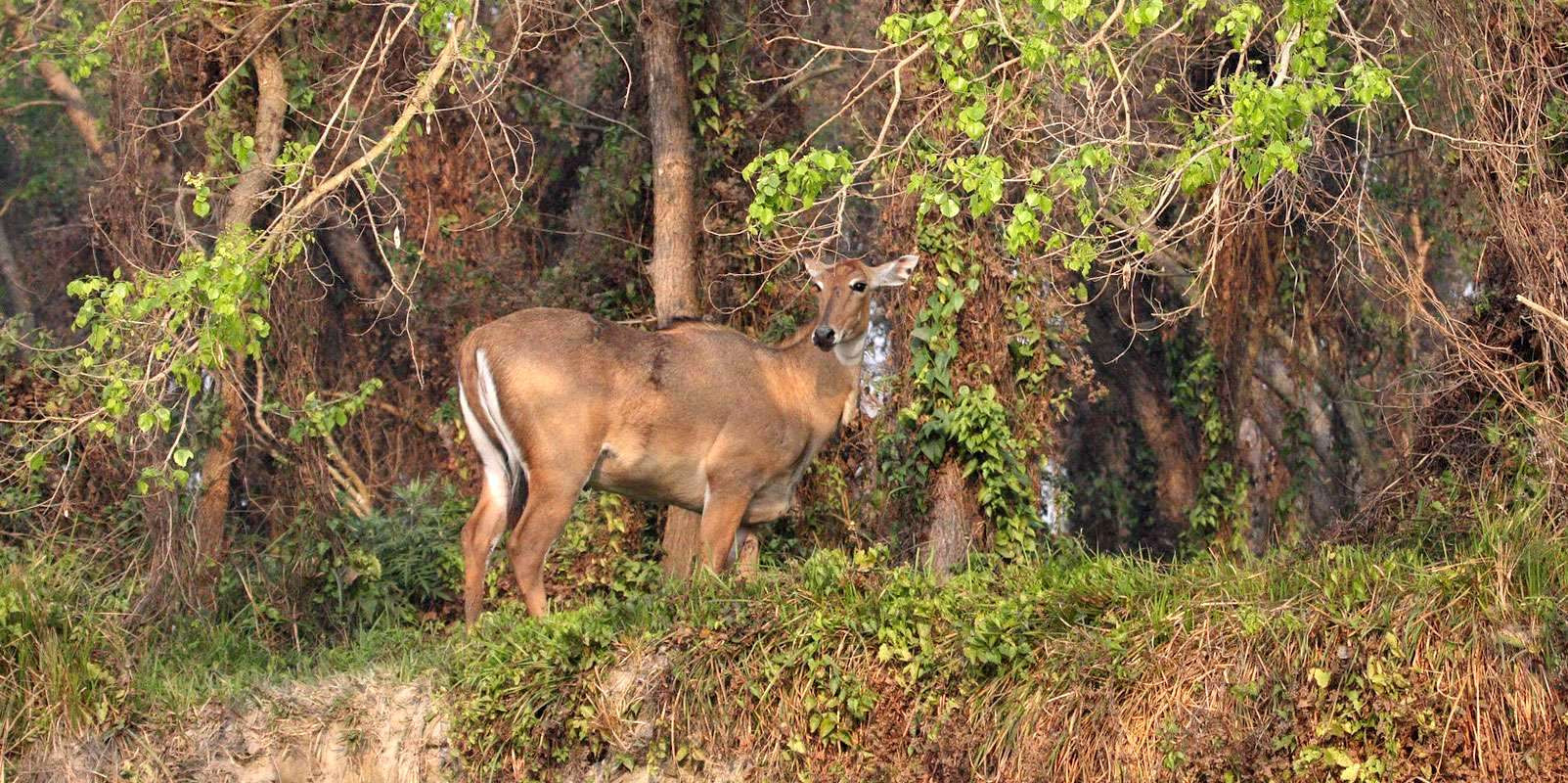
-
Unique Biodiversity: Koshi Tappu Wildlife Reserve boasts an exceptional diversity of bird species, making it a premier destination for ornithologists and bird enthusiasts from around the world. It is home to more than 485 bird species, including many migratory birds that stop over during their annual journeys between wintering grounds in South Asia and breeding grounds in Siberia. The reserve is famous for the sighting of the rare Bengal florican and numerous waterfowl, waders, and shorebirds. Besides birds, Koshi Tappu also supports a variety of other wildlife. Although not typically known for large mammals, it is home to the last surviving population of wild water buffalo in Nepal, known locally as Arna. Other mammal species include the Indian leopard, blue bull, and several species of deer. The aquatic ecosystems in the reserve harbor the endangered Ganges river dolphin, the mugger crocodile, and numerous fish species, which add to the biological richness of the area.
-
Ecological Features: The reserve encompasses a stretch of the Sapta-Koshi River and includes extensive mudflats, reed beds, and freshwater marshes. This variety of habitats contributes to the high biodiversity of the area. The dynamic nature of the Koshi River, with its changing courses and occasional floods, plays a critical role in maintaining the wetland ecosystem that supports such a wide array of species.
-
Conservation and Community Impact: Koshi Tappu Wildlife Reserve is not only crucial for biodiversity conservation but also plays a significant role in the local economy through eco-tourism. Bird watching tours and wildlife safaris attract visitors from across the globe, providing economic benefits to the local communities. Moreover, the reserve has initiated several community-based programs that involve local populations in conservation efforts, such as anti-poaching activities and sustainable resource management. These initiatives help in aligning the interests of conservation with those of community welfare and sustainable development.
-
Challenges and Opportunities: Despite its ecological importance, Koshi Tappu faces several challenges including habitat degradation due to invasive species, pollution, and the effects of climate change which impact the hydrology and biodiversity of the wetlands. Efforts are ongoing to address these challenges through improved management practices, research, and the active involvement of local communities.
Visiting Kioshi Tappu Wildlife Reserve offers a unique opportunity to explore one of Asia’s most important bird habitats and to contribute to the conservation of this vital wetland ecosystem. Whether you are an avid birdwatcher, a nature enthusiast, or simply seeking a tranquil escape from the city, Koshi Tappu provides an enriching and insightful experience of Nepal's natural heritage.
Parsa Wildlife Reserve
Parsa Wildlife Reserve, nestled in the lowland Terai region of Nepal, represents a crucial segment of the country's efforts to conserve its abundant and diverse wildlife. Established in 1984 and later expanded and upgraded to a wildlife reserve in 2005, Parsa spans approximately 637.37 square kilometers. It borders Chitwan National Park to the west and is part of the larger Terai Arc Landscape, a significant conservation area that extends into northern India.
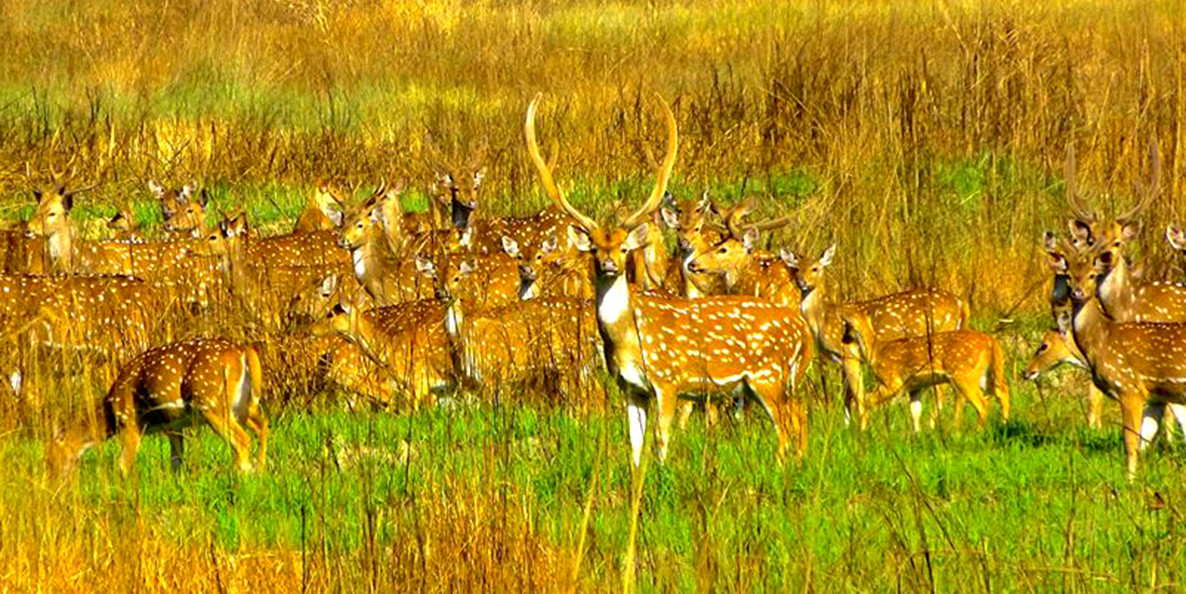
-
Rich Biodiversity: The ecological richness of Parsa Wildlife Reserve is characterized by its lush sal forests, mixed deciduous forests, grasslands, and riverine habitats. This diversity supports a wide array of fauna, including some of Nepal’s most iconic species. The reserve is home to the Royal Bengal tiger, one of its most prized inhabitants, whose numbers have been on the rise thanks to effective conservation efforts. Other significant species include Asian elephants, sloth bears, leopards, and several species of deer such as the spotted deer and sambar. Birdlife in Parsa is also notable, with over 300 species recorded, making it an attractive destination for birdwatchers. The avian population includes a variety of resident and migratory species, enhancing the ecological diversity of the reserve.
-
Conservation Efforts: Parsa Wildlife Reserve's management practices are geared towards preserving habitat integrity while promoting biodiversity conservation. These efforts are bolstered by anti-poaching units and habitat restoration projects which are critical given the reserve’s proximity to populated areas and susceptibility to poaching and illegal logging. The expansion of the reserve in recent years has been a key strategy in creating a larger, more viable habitat for wide-ranging species like tigers and elephants, allowing them a broader territory to roam and thus supporting their growing populations.
-
Community Involvement and Eco-Tourism: Engaging local communities in conservation activities is a cornerstone of the reserve’s strategy. Through education and participation in eco-tourism ventures, locals have become active protectors of the wildlife and natural resources. Eco-tourism provides a sustainable economic incentive for communities to preserve their natural heritage. Activities such as guided jungle walks, wildlife safaris, and cultural tours offer visitors a glimpse into the rich biodiversity and cultural tapestry of the area.
-
Challenges and Future Directions: Despite successful conservation initiatives, Parsa Wildlife Reserve faces ongoing challenges such as human-wildlife conflict, particularly with elephants and leopards. Further, the illegal wildlife trade and habitat encroachment remain significant threats. Addressing these challenges requires continued collaboration between conservation authorities, local communities, and international partners.
Visiting Parsa Wildlife Reserve offers an authentic wilderness experience and the opportunity to observe some of Nepal’s most fascinating wildlife in their natural habitat. It’s a place where conservation meets adventure, providing an ideal setting for those looking to explore the untamed beauty of Nepal’s Terai region.
Shuklaphanta Wildlife Reserve
Shuklaphanta Wildlife Reserve, located in the far-western Terai of Nepal, is a vibrant ecosystem known for its extensive open grasslands, marshes, forests, and a sizeable lake. Originally established as a hunting reserve in 1969 and later converted into a wildlife reserve in 1976, Shuklaphanta covers an area of approximately 305 square kilometers. It was expanded in 2004 to include additional forests and grassland areas, enhancing its capacity as a biodiversity sanctuary.
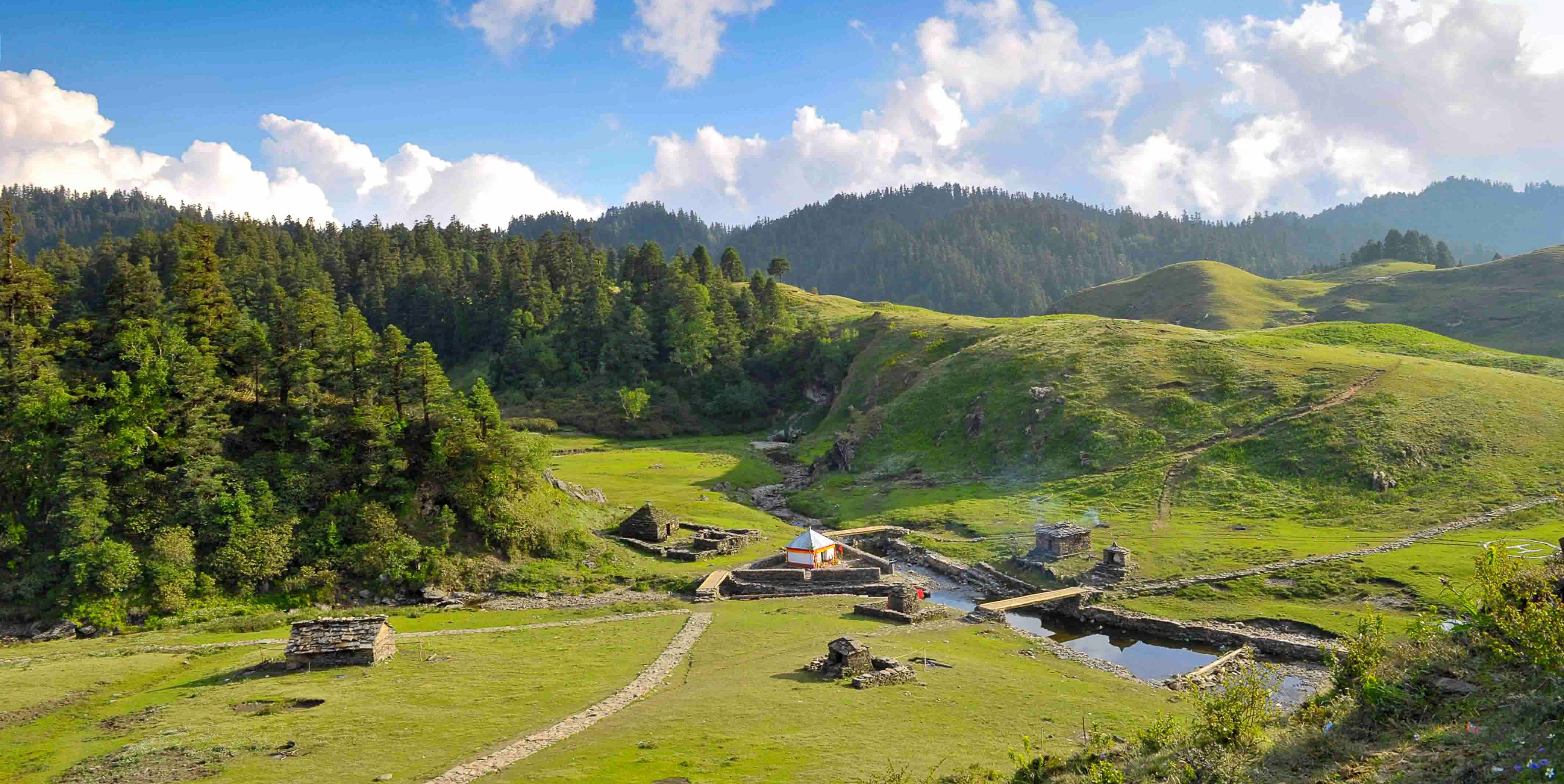
-
Biodiversity and Unique Habitats: Shuklaphanta is distinguished by its vast phantas or grasslands, which are among the largest and most pristine in Nepal. These grasslands are crucial for many species, particularly the swamp deer, of which the reserve hosts one of the largest populations in the world, numbering over 2,000 individuals. The reserve's name itself is derived from the large grassland area called Shukla Phanta. The reserve is also home to a significant number of other wildlife species. It boasts one of the highest tiger densities in Nepal, thanks to its abundant prey and effective conservation measures. Other notable species include the Indian leopard, Asiatic elephant, and the rare hispid hare. Reptiles, such as the gharial crocodile and various species of snakes, along with numerous fish species, contribute to the ecological diversity.
-
Bird Life: Shuklaphanta Wildlife Reserve is a haven for bird watchers, with over 424 bird species recorded, including several migratory species. The reserve is especially famous for the Bengal florican, a critically endangered bird that finds a safe haven in the grasslands. The serene lakes and marshes attract numerous waterfowl, making it an excellent spot for bird observation and photography.
-
Conservation Efforts: Conservation efforts in Shuklaphanta are focused on protecting and managing its rich biodiversity. These include habitat management, anti-poaching patrols, and community engagement initiatives. The reserve's management practices are designed to maintain the ecological balance and ensure the protection of its key species, particularly the swamp deer and the Royal Bengal tiger.
-
Community Involvement and Sustainable Tourism: The involvement of local communities is vital to the success of conservation efforts in Shuklaphanta. Eco-tourism has been promoted as a means to provide economic benefits to the local population, thereby incentivizing conservation. Activities like guided jungle tours, wildlife safaris, and cultural experiences are encouraged, fostering a sustainable relationship between tourism and conservation.
-
Challenges and Opportunities: Like many protected areas, Shuklaphanta faces challenges such as human-wildlife conflict, habitat encroachment, and the impacts of climate change. Efforts to expand the reserve's area and improve biological corridors are ongoing, aimed at enhancing habitat connectivity for migratory species and reducing edge effects.
Shuklaphanta Wildlife Reserve remains one of Nepal's hidden gems, offering a unique wilderness experience away from the more frequented tourist paths. Its vast grasslands, rich wildlife, and commitment to conservation make it a must-visit for nature lovers and those interested in the conservation of Nepal's natural heritage.
Hunting Zone
In Nepal, the concept of a hunting zone is specifically designated in the form of the Dhorpatan Hunting Reserve, which is the only area in the country where licensed hunting is permitted. This reserve plays a unique role in Nepal's conservation efforts, balancing the preservation of wildlife with controlled hunting practices to manage animal populations and generate revenue for conservation and local community development.
Dhorpatan Hunting Reserve
Located in the Dhaulagiri Himal range in the western part of Nepal, Dhorpatan Hunting Reserve covers an area of approximately 1,325 square kilometers. It was established in 1987 and is situated at altitudes ranging from 2,850 to 5,500 meters. The landscape is diverse, including flat meadows, steep slopes, and dense forests, making it an ideal habitat for various wildlife species.
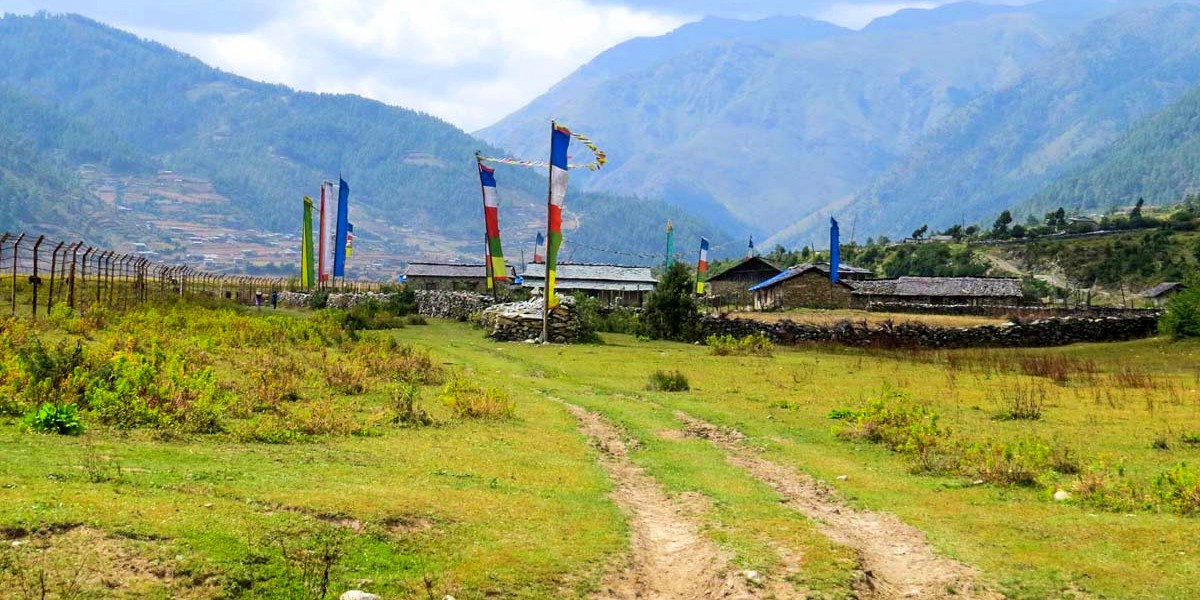
-
Wildlife and Hunting Management: The reserve is famous for its populations of blue sheep and Himalayan tahr, which are the primary species available for licensed hunting. Other wildlife in the reserve includes the leopard, goral, serow, pheasant, and partridge, although these species are protected and not available for hunting. Hunting in Dhorpatan is carefully regulated to ensure sustainable wildlife management. Hunting quotas are established each year based on scientific assessments of animal populations, ensuring that the hunting activities do not adversely affect the overall wildlife population. Only a limited number of hunting licenses are issued annually to both Nepali citizens and foreign visitors, with strict regulations governing the hunting seasons and methods used.
-
Conservation and Community Benefits: Revenue generated from hunting licenses contributes significantly to conservation efforts within the reserve and supports local community projects. This financial contribution aids in funding anti-poaching patrols, wildlife research, and habitat conservation activities. Additionally, the hunting reserve helps to mitigate human-wildlife conflicts by managing the populations of species that may impact local agriculture.
-
Eco-Tourism and Other Activities: While hunting is a focal activity in Dhorpatan Hunting Reserve, the area is also popular for eco-tourism. Non-hunters can enjoy trekking, bird watching, and experiencing the unique cultural heritage of the local communities. The reserve's rich biodiversity and relatively untouched natural environment offer a perfect setting for nature enthusiasts and photographers.
-
Challenges and Sustainability: The management of Dhorpatan Hunting Reserve faces challenges similar to other protected areas, including poaching, illegal grazing, and the need for more effective community engagement in conservation practices. Ensuring the sustainability of hunting and conservation requires continuous monitoring, community involvement, and adaptive management practices to respond to ecological and social changes.
Dhorpatan Hunting Reserve's model of integrating conservation with regulated hunting and tourism provides an interesting case study in wildlife management and community development. It demonstrates how controlled hunting, when properly managed, can contribute to conservation objectives while supporting local economies and sustainable development in Nepal.
Tips for Protected Areas: Conservation Area, Wildlife reservation and Hunting Zone in Nepal
Visiting protected areas such as conservation areas, wildlife reserves, and hunting zones in Nepal can be an enriching and transformative experience. To ensure a respectful, safe, and enjoyable visit, here are some essential tips to keep in mind:
Respect Wildlife and Natural Habitats
-
Maintain a Safe Distance: Always keep a safe and respectful distance from wildlife. Avoid actions that could stress or threaten animals.
-
Do Not Feed Wildlife: Feeding animals can alter their natural behaviors and diet.
-
Stay on Designated Paths: To minimize your impact on natural habitats, stick to marked trails and paths.
Follow Local Regulations and Guidelines
-
Obtain Necessary Permits: Ensure you have all required permits and tickets for entry, trekking, or hunting. This is crucial for regulated areas like the Dhorpatan Hunting Reserve.
-
Adhere to Guidelines: Follow all rules set by the park or reserve management, including those related to camping, fire use, and waste disposal.
Practice Leave No Trace Principles
-
Pack Out Trash: Carry all your garbage, including organic waste like fruit peels, out of the protected areas.
-
Be Cautious with Fire: Use stoves for cooking rather than open fires, and never leave a fire unattended. Some areas may prohibit fires altogether.
-
Use Biodegradable Products: Opt for environmentally friendly toiletries and detergents to minimize your ecological footprint.
Support Conservation Efforts
-
Contribute to Conservation Programs: Participate in or donate to conservation initiatives. Your contributions help fund wildlife protection, community projects, and habitat restoration.
-
Educate Yourself and Others: Learn about the wildlife, cultural significance, and conservation issues of the areas you visit. Share this knowledge to promote awareness and respect for these environments.
Engage with Local Communities
-
Buy Local: Purchase products and services from local businesses to support the regional economy. This includes hiring local guides, staying in local lodges, and buying local handicrafts.
-
Respect Cultural Traditions: Show respect for local customs, traditions, and religious sites. Dress modestly and ask permission before taking photographs of people or private property.
Prepare Adequately
-
Gear Up Appropriately: Wear suitable clothing and footwear. Conditions in these areas can be unpredictable, so prepare for various weather scenarios and terrain challenges.
-
Stay Informed: Keep up-to-date with local weather and any potential hazards. Always inform someone of your travel plans and expected return time.
Be Prepared for Emergencies
-
Carry a First Aid Kit: Always have a basic first aid kit and know the basics of its use.
-
Know Emergency Contacts: Have the contact information for local emergency services, and understand the procedures for getting help if needed.
By following these tips, your visit to Nepal's protected areas will not only be enjoyable but also contribute positively to the preservation of these precious environments and their communities.
Best Time to Visit Protected Areas: Conservation Area, Wildlife reservation and Hunting Zone in Nepal
Visiting protected areas in Nepal, including conservation areas, wildlife reserves, and hunting zones, can vary significantly depending on the region and what you hope to see or do. Each season offers unique experiences and challenges. Here's a guide on the best times to visit these areas:
Spring (March to May)
-
Weather: Spring is one of the best times for visiting protected areas in Nepal, especially for trekking in the higher altitudes of conservation areas like Annapurna and Manaslu. The weather is generally warm and dry, providing clear views of the mountains.
-
Wildlife and Flora: This is a fantastic season for wildlife viewing as animals are more active. It's also the breeding season for birds, making it excellent for bird watching. The forests and hillsides are vibrant with rhododendrons and other wildflowers.
Summer/Monsoon (June to August)
-
Weather: The monsoon season can be challenging due to heavy rains, which may lead to slippery trails and leeches in forested areas. However, the landscapes are lush and waterfalls are at their most spectacular.
-
Wildlife and Flora: This is not the ideal season for mountain views or high-altitude trekking but can be great for exploring the biodiversity of lower altitude reserves like Koshi Tappu Wildlife Reserve, where the vegetation is lush and full of life.
Autumn (September to November)
-
Weather: Autumn is another peak season for visitors, especially trekkers. The weather is stable and clear, offering excellent mountain views and comfortable temperatures.
-
Wildlife Viewing: Animals are often easier to spot as they come to lower altitudes. In wildlife reserves, this is an excellent time for viewing as the vegetation starts to thin, improving visibility.
Winter (December to February)
-
Weather: Winter in Nepal is generally cold, especially at higher altitudes, with snow in mountainous areas. However, the skies are usually clear, and days can be sunny and pleasant, particularly in the Terai region.
-
Wildlife Viewing: In regions like Chitwan and Bardia, winter is a great time for wildlife safaris as the cooler temperatures make animals more active during the day. Bird watching is also excellent during this time as migratory birds arrive in the lowlands.
Specific Considerations for Hunting Zones
- Dhorpatan Hunting Reserve: For hunting enthusiasts, the best times are from September to November and from February to April, aligning with the designated hunting seasons for different species.
When planning your visit, always check the specific conditions and requirements of each protected area. Some areas may have restrictions based on the season or particular conservation needs at different times of the year.
Nepal’s protected areas, including conservation areas, wildlife reserves, and the Dhorpatan Hunting Reserve, are crucial for preserving the nation’s biodiversity and supporting sustainable community development. These regions not only safeguard diverse ecosystems and endangered species but also enhance local livelihoods through eco-tourism and conservation programs. Each area offers unique opportunities for nature lovers to explore and appreciate the natural beauty while contributing to conservation efforts. As stewards of these environments, it is essential for visitors to engage responsibly and support ongoing preservation initiatives, ensuring that Nepal’s natural treasures remain vibrant and intact for future generations.
FAQs for Protected Areas: Conservation Area, Wildlife reservation and Hunting Zone in Nepal
Q: Do I need a permit to enter protected areas in Nepal?
A: Yes, most protected areas in Nepal require visitors to obtain entry permits. These can be acquired at the entrance of the park or sometimes in nearby major cities. Fees and requirements vary depending on the area and the visitor's nationality.
Q: Are there specific regulations I should be aware of when visiting these areas?
A: Visitors should adhere to regulations designed to protect the environment and wildlife, which include not feeding or disturbing wildlife, sticking to marked trails, carrying out all trash, and respecting local customs and cultural sites.
Q: Can I participate in hunting in Nepal?
A: Legal hunting is allowed only in the Dhorpatan Hunting Reserve, where visitors can hunt certain species during specific seasons with a proper license, strictly regulated to ensure sustainable wildlife management.
Q: What should I bring for a visit to these areas?
A: Pack appropriate clothing for varying weather conditions, sturdy trekking shoes or boots, binoculars for bird and wildlife watching, a first aid kit, and necessary permits and identification.
Q: How can I minimize my impact while visiting protected areas?
A: Minimize your impact by following the Leave No Trace principles, using eco-friendly products, supporting local economies by hiring local guides and purchasing local goods, and participating in conservation and community initiatives.
For the Nepal tour, please click here.
If you are looking for different kinds of Nepal Tours or Trekking Packages, feel free to contact us.
